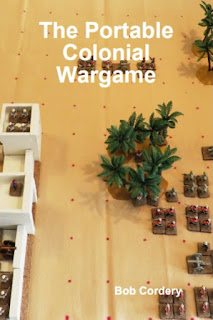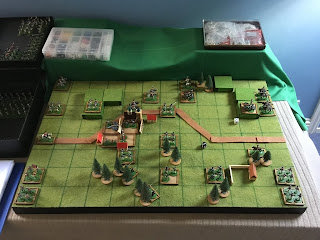The Allied force makes its way cautiously forward - the Rifles in the foreground whilst the infantry and artillery reach the outskirts of the village.
Clad in their uniforms of Rifle green the two detachments of the 95th trotted at the double to secure the irregular tree line to the right of the village. Once in position they would be able to cover most of the approaches on the far side of the village. Hyde-Bowned had deployed his cavalry on the left flank to perform a similar function to the 95th, albeit at arms length. He directed his artillery to the village supported by a single battalion of British infantry. The Belgians were for the most part in reserve and so he planned to feed them into the action as required although he had grave misgivings about their competence, so much so in fact, he resolved to stay in close proximity to them.
The artillery deployed facing the village at close range whilst the infantry cautiously took up positions on the far side of where the French were likely to appear.
The French begin their rather haphazard advance towards the village
Despite command bungles and delays Enstarr managed to get his troops moving and immediately threw two battalions straight dozen the main road into Chimay whilst he also occupied the small farm on his left. His artillery, although located on a hill and just able to reach the village were too far away to be useful as were his cavalry.
It would be a race to see who could secure the village first.
The situation after the initial manoeuvring to secure an advantageous position.
The Allies were first into the village but they did not have to wait long until their erstwhile adversaries announced their imminent arrival with much drumming and shouts of ‘Vive L’Empereur!’ Meanwhile, the Rifles began to take up their positions in the edge of the woods, ideally placed to support the village and to watch the approaching French columns.
An overview of the situation as the battle for the village is about to begin
The first detachment of the Rifles about to open fire on the advancing French columns
Both commanders knew that the battle for the village would be decided in the village and so this proved to be correct as the fortunes of war ebbed and flowed back and forth. The dash and elan of the French columns was first blunted and then shattered against the resolute defence conducted by the men of the 30th foot and the supporting artillery but at a heavy cost. At one point the French had reached the edge of the village and had not only defeated the British infantry but had also forced the artillery back. It was too late though as by this time events had moved on dramatically on either flank.
The battle for the village gets underway as losses are suffered by both sides
Meanwhile the Belgian infantry starts to move up to support the 30th in the village and the cavalry takes up a watching brief on the Allied left flank just as one of the French guns limbers up and moves ahead supported by a unit of Dragoons. More French infantry approach the village.
Both sides rush to reinforce the village but the advantage appears to be with the French at the present.
The overall situation with the Allied cavalry moving to stem the developing French combined arms attack
Whilst the battle raged in the village the Allied cavalry had observed enemy movement to their front and so with their usual aplomb and technical skill immediately launched two charges - the Lifeguards headlong at a French column whilst the Scot’s Greys looked at the French limbered artillery with eager eyes. Unfortunately for the cantankerous horsemen they had misjudged the distance to the artillery and were in full flight when their charge was checked by the French Dragoons.
More French infantry move into the village whilst the Lifeguards threaten an approaching French column. The Scot’s Greys, in full flow, fail to reach their intended target
Both detachments of the Rifles are in action and causing niggling casualties to the approaching French columns whilst the Belgians move up in support. The Lifeguards fall back as the advancing French form square. The French artillery quickly unlimber and engage the onrushing Scot’s Greys but fortunately for the onrushing horsemen their fire is rushed and ineffective.
The overall situation as the Allies hang on in the village but are successfully blunting the French attempts to reinforce their assault force.
The Rifles continue to cause discomforting casualties whilst the Belgians step in to support the artillery against the onrushing Frenchmen. The 30th foot are finally pushed out of their position after a long and gallant fight. With the French virtually in possession of the battered village the battle heads towards its climax. The Scot’s Greys trade blows with the Dragoons and quickly gain the upper hand. Only the Belgians remain to turn the tide as the rest of the British infantry are too far away to lend assistance in time.
The furthest French advance in the village with the Belgians already in action and reestablishing the Allied hold on Chimay.
The end in sight. The French attack on Chimay is spent with the Allies well placed to reinforce their foothold in the village.
Hyde-Bowned knew that the crisis of the battle had arrived. The Belgians fought ferociously and quickly chased the few remaining Frenchmen from the village whilst the Rifles continued to harry and harass the milling columns.
The Belgians push on through the village
Enstarr knew that the end was near. His attacking infantry had been ground down by intense musketry and well directed artillery fire. There was more infantry moving up as well as two regiments of Cuirassiers but he knew this was an empty gesture. At least it would enable his troops to be able to fallback and regroup.
As the remnants of the French are chased from the village the Allies prepare to advance to consolidate their position on the field. The French Cuirassiers are moving up to provide a rearguard and to support the infantry currently in square.
The Rifles advance, harrying the retiring French whilst the victorious Belgians consolidate their position in Chimay.
Across the field the French, with the exception of the Cuirassiers and the infantry still in square, are falling back to their start line. Enstarr still had a useful force available but his troops were exhausted. He would regroup and consolidate whilst awaiting fresh orders but the first nagging seeds of doubt had been sown about the fallibility of his Emperor.
Hyde-Bowend was jubilant as he surveyed the wreck of the French army streaming from the village back the way they had come. Despite some rather desultory command decisions his forces had done all that he asked of them although it was a close run thing.
The Duke confers with Hyde-Bowned whilst the gallant Belgians consolidate their hold on the village
As he trotted into the centre of the village to the hitherto unaccustomed cheering of his Belgian troops he felt well satisfied at a job well done. It was only when he turned to accept the raucous adulation that he realised it was in fact for the Duke who had ridden up to see how the day had gone.
His time would come.















































